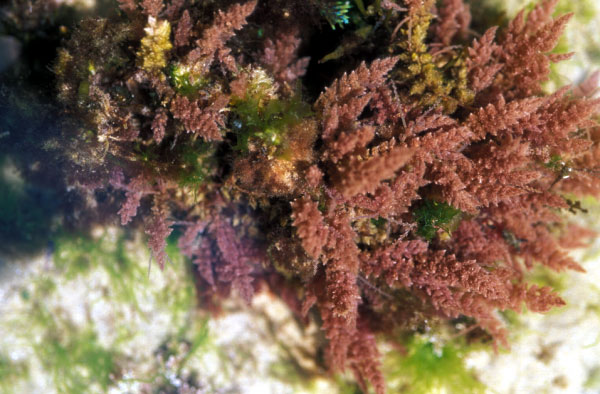Asparagopsis armata Harvey

Also known as Falkenbergia rufolanosa Harvey
Description: Gametophyte plants occurring from June or July - August or September (sometimes overwintering), pale purplish-red, quickly degenerating when removed from the water and becoming distinctly orange; fronds bushy, with a cylindrical axis to1 mm wide and 200 mm long, arising from bare, creeping stolons; irregularly branched, with 4 rows of branchlets, simple, short, branchlets alternating with longer ones with 4 rows of simple filamentous ramuli. Lower branchlets unbranched, long, tapered, with harpoon-like barbs. Tetrapsorophyte (Falkenbergia-phase) occurring all year round, but most obvious in October-March, brownish-red, much branched, filamentous, in dense cotton-wool-like tufts to 15 mm in diameter.
Habitat: Both phases readily reproduce vegetatively. Drift specimens of gametophyte readily attach to other algae by barbed branchlets, and produce new shoots. Introduced from the Southern Hemisphere, the gametophyte was first recorded in Europe in 1925 (Cherbourg and Biarritz), arriving in the British Isles at Galway in 1941, and is now well established in open sandy pools of lower intertidal and subtidal, on rock or epiphytic (mainly on Ulva spp.) in the Channel Is, S England (Swanage to Scilly Is.) and S and W Ireland (Carnsore Pt, Co. Wexford; Magharees Lagoon, Co. Kerry; and from Finavarra, Co. Clare north to Clare I., Co. Mayo). Tetrasporophytes (Falkenbergia -phase) are epiphytic, especially on Corallina officinalis, in similar habitats to gametophyte, but more widely distributed on western and southern coast N to Shetland Is.
Similar species: Bonnemaisonia hamifera occurs in similar habitats but has crozier-shaped attachment branchlets rather than recurved barbs.
Key characteristics: The harpoon-like hooks and bushy habit are unmistakable; association with Ulva rigida and similar species.
Link: Algaebase
Photographs © M.D. Guiry





